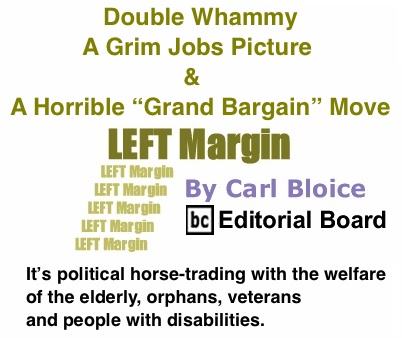


What unfolded in the corridors of
power in the nation’s capital last week portends a serious blow to the interest
of country’s working people and it came hard from two directions.
“First, a terrible jobs report,
then a Democratic President offers a budget that proposes cuts to Social
Security and Medicare,” wrote Dave Johnson of the Campaign for
What they actually heard was Austerity
2013 –
One unnamed “senior administration official” told a briefing last week, “The president has made clear that he is willing to compromise and do tough things to reduce the deficit, but only in the context of a package like this one that has balance and includes revenues from the wealthiest Americans and that is designed to promote economic growth. That means that the things like CPI that Republican leaders have pushed hard for will only be accepted if congressional Republicans are willing to do more on revenues. This isn’t about political horse-trading; it’s about reducing the deficit in a balanced way that economists say is best for the economy and job creation. That’s why the president’s offer - which will be reflected in his budget - isn’t a menu of options for them to choose from; it’s a cohesive package that reflects the kind of compromise we should be able to reach.”
Not “political horse-trading”? You
could have fooled me. No one even maintains that the “chained CPI,” is going to
reduce the federal budget deficit. It’s a chit the President has put on the
negotiating table.
It’s irritating when political
pundits come up, as Josh Voorhees did the other day at Slatest.com, with
various versions of: “Most notably, that means significant cuts to Social
Security and Medicare, and fewer tax hikes than he’d like - neither of which
will please the left.” Why? Because the “grand bargain” being concocted in
“Look, this is compromise,” White
House senior adviser, Dan Pfeiffer, said last Sunday. “And compromise means
there are going to be some folks on both sides who are not happy.” “Yes,
legislative deals require compromise,” economist Robert Reich wrote on his blog
last month. “But why is it that deals over economic policy almost always
compromise away what a majority of Americans want?”
This is not “everybody doing his
part,” as Gene Sperling, assistant to the President
for economic policy told the nation the other day. It’s political horse-trading
with the welfare of the elderly, orphans, veterans and people with disabilities
on the table.
“While cutting Social Security
makes no sense at all in terms of economics or public policy, it makes excellent
sense in terms of the selfish class interests of the super-rich,” wrote Michael
Lind in Salon.com April 5. “They have
extracted about half the gains from economic growth in the
“This morning’s jobs report was a
big negative surprise and underscored the fact that a robust jobs recovery, even
now, has not yet solidified,” observed Economic Policy Institute economist Heidi
Shierholz April 5. “The job growth of 88,000 in March
was far lower than the 2012 average increase of 183,000. It is important to
keep in mind that the month-to-month numbers can be volatile, however; in this
case the first quarter average growth rate is likely a better measure of the
underlying trend. But at 168,000 per month, the average growth rate of the
first quarter is not even close to what we need - at that rate we would not get
back to the pre-recession unemployment rate until late 2019.”
“The unemployment rate ticked down
to 7.6 percent in March, but not for good reasons,” continued Shierholz. “The decline is due to people dropping out of
the labor force, not an increase in the share of the working-age population
with jobs. In fact, the labor force participation dropped to its lowest point
of the downturn, 63.3 percent. What’s more, the weak labor force participation
is not due to demographic factors like retiring baby boomers; the labor force
participation rate of the ‘prime-age’ population, people age 25-54, is also at
its lowest point of the downturn, 81.1 percent. It’s the lack of job
opportunities – the lack of demand for workers - that is keeping these workers
from working or seeking work, not other factors.”
African-American unemployment slipped
from 13.8 to 13.3 percent in March and black teen joblessness fell from 43.1 to
33.8 percent. How much of that is the result of black people finding sought
after jobs was not immediately clear. However, the labor participation rate for
African Americans as a whole remained about the same over the month.
“What’s most concerning about
these trends is the prolonged double-digit rates of unemployment for African
American, Latino and less-educated workers,” Tamara Draut,
Vice President of Policy and Research at Demos
and author of Strapped: Why America's 20- and 30-Somethings Can't Get Ahead
, recently observed. “While
much attention has been paid to the challenges facing indebted college
graduates who are now much more likely to be working in jobs that don’t require
a college degree, the deep and persistent high levels of joblessness and
under-employment among young people without four-year degrees (the majority of
the generation) is a silent crisis facing our nation. And it demands a robust
and national response.”
Regarding the March jobs numbers, Congressional
Black Caucus Chair Marcia Fudge said, “The African American unemployment rate
fell .5 percent to 13.3 percent, the most it has fallen in six months. However,
that number remains at nearly double the national rate with 2.4 million African
Americans still out of work.”
“While the private sector has
steadily added jobs for 37 months, the public sector, where many African
Americans are employed, continued to lose them. Last month, 385,000 more
requests for unemployment benefits were made and by year’s end, sequestration
threatens to put an additional 750,000 people with full time jobs out of work,”
Fudge added.
Daniel Gross, global business
editor at Newsweek’s Daily Beast,
wrote that he had found a “small potentially optimistic note” in the latest
government employment report. A major problem, he wrote is that while the
private sector has been recently adding jobs to the economy cutbacks in the
public sector have been “holding back the recovery in overall employment,”
having eliminated millions of jobs “in part by firing police officers and
teachers.”
Gross noted the situation with
regards to public sector jobs at the state and local levels, last month: “The
federal government cut about 14,000 positions, with most of those coming from
the postal service.” “The non-Washington austerity hit to payrolls may finally
be coming to an end,” he continued. “That’s the good news. The
bad news? The
If and when the “grand bargain”
being pushed by the White House goes into effect it will make matters even
worse.
“The optimist in me sees that yet
again we had upward revisions and simply wants to believe that these March numbers
are wrong and will be revised upward,” wrote columnist Matthew Yglesias at Slate
Moneybox. “But hope is not a plan.”
Nor does anyone seem to have one.
No, that’s not true. There’s the
Congressional Progressive Caucus budget that is far more sensible and humane
than anything the White House is proposing. But since the “serious” people in
As Jim Dean, the chair of
Democracy for
“With this move, Obama gives
progressives one less reason to work for Democrats - and every American citizen
one less reason to vote for them,” Progressive
magazine editor, Matthew Rothschild, wrote last week.
According to the AARP, its polling
says 70 percent of voters age 50-plus are opposed to the chained CPI gambit and
two-thirds of them – including 60 percent of Republicans - say they would be “considerably
less likely” to support a congressional candidate if he or she supported it. As
Solon’s Joan Walsh reported, “On
every single question, Republicans lag only a point or two behind Democrats in
their opposition to Social Security cuts.”
And, just in case, the
“Remember the catastrophe of 2010,
when millennials stayed home in large numbers,” Pugh
writes. “Polling data shows that a solid majority of young adults (53 percent)
wanted a Democrat-controlled Congress. However, only 20.9 percent of all
eligible young people voted in the 2010 midterms. More than half of the people
who voted in 2008 (51 percent) shied away from the polls. In the months leading
up to November 2014, Democrats will have to try even harder to win the
millennial vote. Republicans are already poised to make some headway: note the
thousands of young people at the Conservative Political Action Conference a few
weeks ago.”
“As the most diverse generation
(39 percent are people of color), millennials are
more civically engaged, progressive, open to change and tolerant non-meddlers
on social issues. Overwhelming, they support same-sex marriage (78 percent), abortion
rights (68 percent), and immigration reform (78 percent). Democrats’ stance on social issues are the main draw for young voters.”
“But demography isn’t destiny. It
would be suicidal for Democrats to take for granted a group that will comprise
almost a quarter of the electorate in 2014. Progressive views on social issues
are appreciated, but are not sufficient. The number one priority of millennials and the rising American electorate is still
economic recovery - and millennials need to see
Democrats being the champions of a recovery that will allow them to rise.”

BlackCommentator.com Editorial Board member and Columnist Carl
Bloice is a writer in





